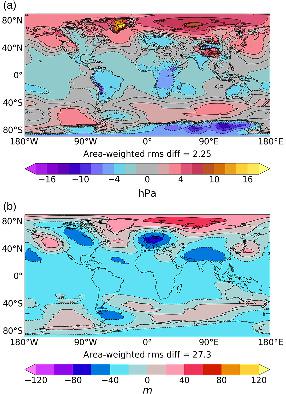当前位置:
X-MOL 学术
›
Q. J. R. Meteorol. Soc.
›
论文详情
Our official English website, www.x-mol.net, welcomes your feedback! (Note: you will need to create a separate account there.)
Addressing the causes of large‐scale circulation error in the Met Office Unified Model
Quarterly Journal of the Royal Meteorological Society ( IF 8.9 ) Pub Date : 2020-05-16 , DOI: 10.1002/qj.3807 K. D. Williams 1 , A. Niekerk 1 , M. J. Best 1 , A. P. Lock 1 , J. K. Brooke 1 , M. J. Carvalho 1 , S. H. Derbyshire 1 , T. D. Dunstan 1 , H. S. Rumbold 1 , I. Sandu 2 , D. M. H. Sexton 1
Quarterly Journal of the Royal Meteorological Society ( IF 8.9 ) Pub Date : 2020-05-16 , DOI: 10.1002/qj.3807 K. D. Williams 1 , A. Niekerk 1 , M. J. Best 1 , A. P. Lock 1 , J. K. Brooke 1 , M. J. Carvalho 1 , S. H. Derbyshire 1 , T. D. Dunstan 1 , H. S. Rumbold 1 , I. Sandu 2 , D. M. H. Sexton 1
Affiliation

|
The Met Office Unified Model develops a systematic error consisting of a large high‐pressure bias over the North Pole. The error begins to develop early in numerical weather prediction forecasts and is the leading large‐scale circulation error in the model's climatological mean, with implications for principle circulation regimes and blocking. The cause of the error is investigated using a variety of diagnostic techniques, including analysis of a perturbed parameter ensemble for the model, evaluation of changes in both weather and climate simulations to minimise the risk of introducing compensating errors, and detailed comparisons with another model. A reduction in this systematic error is achieved through an overall reduction in the near‐surface drag; however, to accomplish this without affecting forecast predictability adversely, a redistribution of the drag is required between the roughness from vegetation in the land‐surface scheme, the near‐surface drag from the orographic gravity‐wave drag scheme, the turbulent orographic form drag, and the resolved drag (through changing the orographic filtering). A modest reduction in the climatological bias is achieved, along with a reduction in bias and improved predictability of near‐surface winds.
中文翻译:

解决Met Office Unified Model中大规模流通错误的原因
大都会办公室统一模型会产生系统错误,其中包括北极上方的高压偏斜较大。该误差开始于数值天气预报的早期,并且是该模型气候平均值中主要的大规模环流误差,对主要的环流制度和阻塞有影响。使用各种诊断技术来调查错误的原因,包括分析模型的扰动参数集合,评估天气和气候模拟的变化以最大程度地降低引入补偿错误的风险,以及与另一个模型的详细比较。通过整体减少近地表阻力可以减少这种系统误差。但是,要做到这一点而又不会不利地影响预测的可预测性,需要在地表方案中来自植被的粗糙度,地形重力波阻力方案中的近表面阻力,湍流地形形式阻力和解析阻力之间进行阻力的重新分配(通过更改地形过滤) 。气候偏差得到了适度的降低,偏差也得到了降低,近地表风的可预测性得到了提高。
更新日期:2020-05-16
中文翻译:

解决Met Office Unified Model中大规模流通错误的原因
大都会办公室统一模型会产生系统错误,其中包括北极上方的高压偏斜较大。该误差开始于数值天气预报的早期,并且是该模型气候平均值中主要的大规模环流误差,对主要的环流制度和阻塞有影响。使用各种诊断技术来调查错误的原因,包括分析模型的扰动参数集合,评估天气和气候模拟的变化以最大程度地降低引入补偿错误的风险,以及与另一个模型的详细比较。通过整体减少近地表阻力可以减少这种系统误差。但是,要做到这一点而又不会不利地影响预测的可预测性,需要在地表方案中来自植被的粗糙度,地形重力波阻力方案中的近表面阻力,湍流地形形式阻力和解析阻力之间进行阻力的重新分配(通过更改地形过滤) 。气候偏差得到了适度的降低,偏差也得到了降低,近地表风的可预测性得到了提高。



























 京公网安备 11010802027423号
京公网安备 11010802027423号